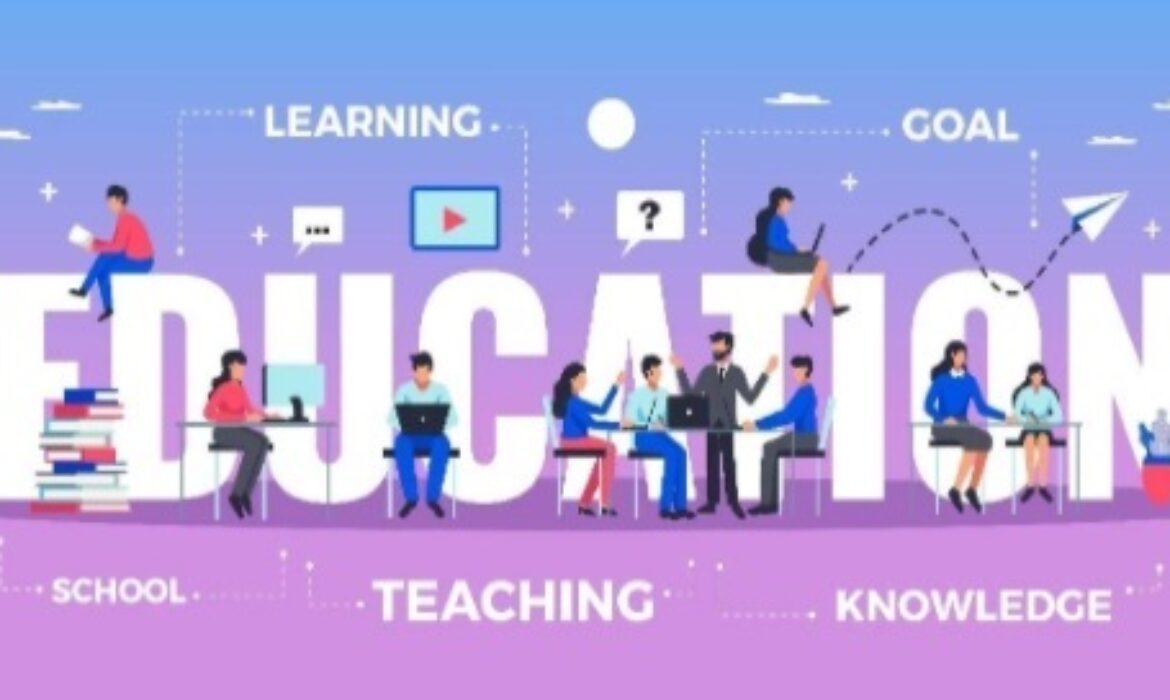How iCloudEMS strengthens the digital capabilities of Higher Education with its Online Classes and Examination management system
Technology has proven its true potential by revolutionizing the conventional teaching learning methodologies and bringing the transformation in Higher Education. Our government has never left any stone unturned to leverage technology in stretching the wings of the Education system to make it accessible and affordable for every student worldwide. COVID-19 has accelerated the deployment of the Education Management System to support uninterrupted Education learning and administration. Online Classes and Examination management System is a cloud-based solution that simplifies the administration intricacies of Classes and Examination. It removes the physical barriers in delivering and assessment of student-centric quality education.
Now, let’s understand the importance of Online Classes and Examination system
Online Classes management:

COVID-19 has made the Institutes transform their traditional classroom-led teaching-learning practices with Online or Virtual learning sessions in blink of an eye and the best part is both faculty and students have leveraged the latest technologies to access quality E-learning and Examination. iCloudEMS has offered a plethora of digital possibilities for an enriching learning experience using online whiteboards, video conferencing, learning management system, instant messaging and many more tools to connect students and instructors any time and from anywhere over the internet. We cater the specific needs of learners with our versatile digital resources for both LIVE and recorded sessions to channelize the valuable efforts of instructors towards a flexible and progressive student-centric learning environment. The major advantages of our Online Classes product are:
- We deliver an online platform where both teachers and students are free to arrange their learning according to their mutual preferences and learning styles to fill in the gaps and improve outcomes.
- Our advanced learning methodology tends to promote pupil-teacher and peer networking across borders and cultural boundaries, making it easier to incorporate research and innovation into learning theories.
- We offer online cloud-based documentation and repository that makes 24/7 access to study materials and progress records that facilitates digital governance of learning goals.
- Our system is an economical learning investment that can easily be afforded with reasonable service subscriptions and a one-time hardware expenditure.
Online Examination and Evaluation:

iCloudEMS brings a comprehensive cloud-based Online Examination System that simplifies the myriad of tedious and challenging Examination and Evaluation responsibilities with efficient management of material and human resources. The important features of our product include:
- Automatic scheduling and posting of examination datasheets that eliminates expected scheduling conflicts between exams on the same day.
- Collaborative question paper setting mechanism that makes the faculty members to easily coordinate with each other and higher authorities to ensure outcome-based learning assessment that follows OBE and Bloom’s taxonomy guidelines.
- Automated approach for assigning invigilation duties and exam centre to faculty members on different groups of students that streamlines the administration to conduct multiple exams with many students at the same time.
- Our LIVE proctoring attribute includes fool proof invigilation feature that ascertains integrity of Examination under a reliable digital-driven environment.
- The digital ecosphere safeguards the purity of evaluation by making the answer sheets and results completely immune to tampering.
- We present a labour-saving strategy that minimizes the time of assessment and publishing results under a transparent avenue for all the stakeholders.
The importance of online education and on-demand examination has been advocated in the National Education Policy (NEP) 2020 to encourage skill-oriented learning practices. It galvanizes the use of digital platforms and the latest learning endeavors like national MOOC courses, DIKSHA and SWAYAM to empower sustained quality education globally. Recent unfavorable situations such as epidemics and pandemics have necessitated utilizing ICT-based education while addressing all potential hurdles. iCloudEMS is a game changer and has always been supportive of institutes’ technical demands in order to foster a modern education atmosphere in a digitally driven environment where one can reap the unseen benefits in situations where traditional classroom learning is not viable.
Implementation of iCloudEMS to Ensure Effective Execution of the New Education Policy 2020: Advantages of iCloudEMS in Higher Education Institutes
The twenty-first century has witnessed a tremendous change in every walk of life. The domain of human knowledge is one of them affected by the huge transformation of traditional human life into technology enabled ways of living to excel in rapid growth, creativity, development of critical thinking, and evaluative and cognitive skills. Considering these aspects, the New Education Policy 2020 focused on a holistic approach to education with the slogan ‘light but tight’ regulatory framework to ensure integrity, transparency, and resource efficiency of the educational system through audit and public disclosure while encouraging innovation and out-of-the-box ideas through autonomy, good governance, and empowerment. This National Education Policy envisions an education system that has its origin in Indian ethos. It explicitly believes in transformation of India education system in an innovative way and encourages sustainability into an equitable and vibrant knowledge society, by providing high-quality education to all to prepare India a global knowledge superpower. The aim of education should not only be cognitive development, but it should also aim ta building character and creating holistic and well-rounded individuals equipped with the key skills of the21st century learners. The experiential learning will be adopted, including hands-on learning, arts-integrated and sports-integrated education, story-telling-based pedagogy, among others, as standard pedagogy within each subject, and with explorations of relations among different subjects. Further, the NEP states that the curriculum and pedagogy of the higher education institutions must inculcate a deep sense of respect towards the Fundamental Duties and Constitutional values, bonding with one’s country, and a conscious awareness of one’s roles and responsibilities in a changing world among the learners. The vision of the Policy is to instill a deep-rooted pride in being Indian, not only in thought, but also in spirit, intellect, and deeds, as well as to develop knowledge, skills, values, and dispositions that support responsible commitment to human rights, sustainable development and living, and global well-being among the learners to reflect the image of a truly global citizen. The NEP encourages multidisciplinary and a holistic education system across the sciences, social sciences, arts, humanities, and sports for a multidisciplinary approach to ensure the unity and integrity of all knowledge to enhance competency at the global level. However, the NEP has laid emphasis on the conceptual understanding rather than tradition ways of rote learning or examination-oriented learning. It clearly states the especial attention on ethics and human and constitutional values like empathy, respect for others, cleanliness, courtesy, democratic spirit, spirit of service, self-esteem, respect for public property, scientific temper, liberty, responsibility, pluralism, equality, and justice.
To impart the quality education in the educational institutes and the achieve the goals set by the New Education Policy 2020, the software iCloudEMS plays a significant role in digitalization of learning material, and provides free access anytime, and anywhere. It helps universities and colleges streamline activities—academics, accreditation, admissions, administrative, HR, and outcome-based education. It empowers learners, faculty, and management to collaborate efficiently and use insights effectively, deliver benchmarking quality education while creating personalized learning experience.
Advantages of iCloudEMS to Foster Conducive Learning Environments and Effective Pedagogic Skills
The educational institutes, especially the higher educational institutes aspiring for providing high quality education to the 21st century learners can use this Information and Communication Technology (ICT) based software to achieve the goals of the New Education Policy 2020 and benefit their learners in different ways. Some of the remarkable advantages of iCloudEMS are given below:
- The New Education Policy emphasizes holistic development of learners to instill them with a logical decision-making power, from school education to the higher education and the iCloudEMS foster learning environment and opens avenues to access learning material from anywhere, anytime. Consequently, learners get opportunity to enrich their creative impulse and critical thinking.
- The New Education Policy promotes learners’ cognitive skills and comprehension abilities instead of emphasizing of the traditional ways of rote learning. The iCloudEMS helps learners to transform themselves into cognitive learners by inculcating life skills to interact and compete with the global learners.
- The New Education Policy focuses on learners’ critical, analytical, comprehensive, and competency-based learning skills and abilities. While iCloudEMS supports learners overcome barriers in developing these skills and makes learning strategies easier.
- The New Education Policy envisions on the learner-centric learning environments and iCloudEMS facilities learner-oriented classroom in a unique way. The classic features of the iCloudEMS fulfil needs of learners as well course instructors.
- The New Education Policy promotes outcome-based education where learners and teachers both are aware of the objectives of the outcome based-education, consequently they focus on the desired outcome to make learning comprehensive and effective. The iCloudEMS has been recognized as a milestone in enhancing efficiency and targeted skills of the twenty-first learners.
- As the NEP reiterates on the extensive use of technology in teaching and learning, removing language barriers, increasing access for Divyang students, and educational planning and management, iCloudEMS has proved to be one of the integral tools of imparting teaching-learning activities.
- The iCloudEMS conforms to the NEP (respect for diversity and respect for the local context in all curricula, pedagogy, and policy, always keeping in mind that education is a concurrent subject) and helps the Higher Education Institutes to impart quality education.
- Being one of the technological tools the iCloudEMS established synergy between learners and the course instructors which is core of the New Education Policy 2020.
- The NEP provides flexibility to the learners, so that learners can opt learning programs of their own choice, and thus decide their own paths in life by showcasing their talents and interests. To enrich teaching-learning experience and make learning learner centric, iCloudEMS helps educational institutes to execute the educational strategies of the NEP in an organized way.
- Being an integrated solution to conduct and manage virtual classroom settings and Online examination management for effectual educational activities, the software iCloudEMS fulfills needs of the NEP to conduct online blended and flipped classes. Thus, it caters needs of the stakeholders as well.
How iCloudEMS encourages Blended and Hybrid learning in Higher Education Institutes
The world has adapted many ‘New Normal’ outcomes generated in the light of pandemic COVID-19. Thanks to the advanced Information and technology practices, that have evolved as backbone to renovate the traditional education sector and made it realize its actual potency. Our education administration has shown its unbelievable agility to get trained and leverage the latest technologies in using online platforms to deliver Quality Education and bring the reforms according to the recommendations of NEP 2020 in this challenging time. Blended and Hybrid learning are also the modifications embraced by the Education system to avoid uninterrupted learning in the time of uncertainties.
Difference between Hybrid and Blended Learning
The terms Blended learning and Hybrid learning are used interchangeably most of the time as both incorporate technology in teaching-learning practices to operate efficiently. However, the difference lies in the way to deploy the technological measures; Blended learning is concerned with leveraging technology in classroom learning activities to make the concept clearer and more understandable, while Hybrid learning model is the use of technology to make simultaneous learning sessions available for both the students present in the classroom as well as those present at their own place.
Blended learning is not new model to be adopted, UGC has always put its best efforts to integrate technology in teaching-learning measures of Higher Education System but Pandemic has pushed to implement the same with no other option left whereas Hybrid learning model is an evolved learning model which makes the learning free from any physical barriers by using the digital platform effectively to open the way to explore new technologies to build upon the digital strengths and achieve the learning outcomes.
Higher Education Institutes are required to take a few measures as mentioned below, for the operative implementation of constructive Blended/Hybrid learning that can ensure the quality teaching-learning experience
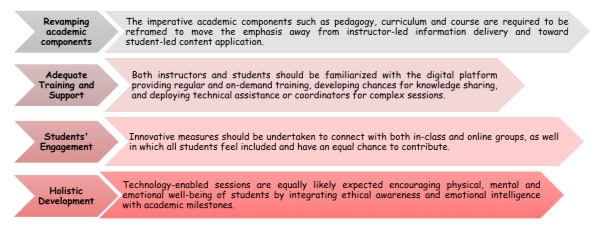
The Online Education System deployed in that time of emergency has made the world reimagine the unthinkable Education practices and future possibilities of using digital tools and technologies to make quality learning available to the student at every part of the globe. NEP 2020 has also advocated some visionary actions to promote the utilisation of technology in teaching-learning methods at Higher Education Institutes. It has recommended incorporating national digital platforms like SWAYAM and DIKSHA to foster multidisciplinary and flexible learning. The establishment of Virtual labs will also encourage hybrid/blended learning in Higher Education Institutes to offer equal access to excellent experiment-based knowledge.
NEP has also emphasised the role of special training and incentives for faculty members to motivate the student-centric learning and advanced pedagogical practices. It has fostered the development of an open, interoperable technology-based infrastructure in the education sector that can provide solutions to the country’s major difficulties, such as India’s size, variety, complexity and improve the digital divide constraints in learning.
Experts have stated that the use of technology driven learning and online platforms will continue to be appreciated and implemented in the post-pandemic Education landscape. Higher Education Institutes are fostered to develop their digital capabilities and explore the benefits of deploying Blended and Hybrid learning model given as:
For the Students:
- Flexible and Self-paced learning
- More engaging sessions than chalk and board ones
- Can govern their own learning.
- Can follow their learning trajectory.
For the Faculty:
- Can be more collaborative and creative than classroom sessions
- Can easily track the learning milestones.
- Can be more time saving than manual handling of academic functions.
- Can experiment with more pedagogical practices for deeper learning.
For the Administrators:
- Can be labour-saving than manual administration.
- Can easily train and upskil the instructors.
- Can have a bird-eye view of academic and non-academic operations anytime and anywhere.
- Better course and faculty management.
Although,the transition of incorporating technology in Education practices brings lot of advantages for every stakeholders yet Higher Education Institutes should prepare themselves to address a few challenges along with such as digital infrastructure that consists of advanced and collaborative digital tools and services to create a secure and updated experience, regular training and support for instructors and students to use updated digital platform and technologies etc.
Therefore a strong technology foundation has become the need of the hour for Higher Education Institutes for achieving the learning goals of the 21st century education system.
iCloudEMS has always taken the utmost care of digital needs of Higher Education Institutes in order to host a digital ecosystem and support student-centered learning. We have always extended our utilities to empower uninterrupted learning experience in every situation. Our primary characteristics that address the technological requirements in the course of implementing Blended and Hybrid learning models in Higher Education Institutes are listed below.
- Cloud-based platform for seamless management of massive data and reports.
- Specialized managed services for the sustenance of Higher Education Institutes’ ERP systems, that brings digital transformation in handling administrative and non-administrative operations in Colleges and Universities.
- We make the course choice and allotment sample for faculty and students under the framework of Choice based Credit System.
- We provide a cloud-based personalised Learning management system to increase student engagement and encourage advanced pedagogy in the teaching-learning.
- Students can access the study material through an online repository using their login credentials, allowing them to learn at their own speed and bridging learning gaps.
- At the end of each topic, rating and feedback systems aid instructors in gaining insights into students’ learning curves and strategic planning of their pedagogical approaches.
- Our interactive Learning Management System (LMS) supports a variety of multimedia formats to help students visualize concepts better.
- Outcome-based education (OBE) has become a must-have for achieving learning objectives. Our outcome-based LMS links teaching and assessment procedures with OBE and Bloom’s taxonomy to assist teachers in the definitive assessment of cognitive abilities of students.
- One of the most essential aspects of education transformation is on-demand examination. The Online Exam Management system provides a disciplined environment for the planning and governance of on-demand examinations while maintaining system integrity.
- Our specialised Student lifecycle management system promotes student-centered learning by integrating a student’s entire academic journey onto a single dashboard that provides an overhead view of the students’ activities and progress, allowing for more efficient tailoring of future plans for students’ overall development.
It can be summarized that in this world of uncertainties, we all are required to learn the way to survive in the digital ecosystem. The fundamental necessity is to strengthen the digital infrastructure of Higher Education Institutes for enriched quality education management without any time or space constraints. Blended and Hybrid learning are tech-integrated models that nourish the 21st century skills in the students in a multidisciplinary culture. iCloudEMS digitally facilitates the organizational and administrative arrangements of Higher Education Institutes to support student-centric and flexible learning that can fulfil the learning preferences and needs of the modern era youth.
How iCloudEMS helps the Higher Education Institutes to manage the entire lifecycle of their students
Students are the core stakeholders in an educational institution; they are the assets of the institutions and they are in charge of bringing distinct vitality to the setting. Once an individual becomes a student of Institution, its responsibility is to make them shine in every sphere of their life by cultivating the bond between students and their alma mater during graduation and beyond. To build a strong relationship that can meet the needs of 21st century students, there must be a well-defined approach towards regular interaction, timely information, and completing the necessary steps to access the actionable data of every student without any time or place constraint.
Student lifecycle is nothing but the whole journey of an individual’s growth in his education ecosystem from being prospective to alumni. This lifecycle of students consists of a myriad of episodes that generate a huge amount of data and many challenges along with regarding compiling and managing such data to achieve great learning outcomes. The meaningful management of the students’ data is the key to attract future generations in an educational institute. Following are the important points of consideration in the path of student lifecycle management:
- Actionable data to access and process anytime and anywhere
- Best action plans to convert the best prospective students.
- Powerful analytical tools to fetch the required statistics.
- Leveraging best available technology for the best possible data management.
Today the main challenge before the Higher Education Institutes is not to get acquainted with the potential of technology to solve their day-to-day complexities while to choose the best product and technology that can keep up with advancements of new needs of student lifecycle management. iCloudEMS is a pioneer of offering advanced technological solutions for seamless resources and workflow management in Higher Education Institutes. Our Student Lifecycle Management System is a comprehensive cloud-based solution to automate and integrate the entire academic journey from inquiry to alumni of all the students in a college or university.
The important functionalities of our labour-saving mechanism include:
Enquiry to Enrolment: Our student lifecycle management system uses interactive dashboards to bring together students, instructors, parents, and administration to guarantee that efficient management of admissions operations. Our cutting-edge features promise to convert potential leads, computerised all pre-admission procedures such as forms, student information, documents, and more. Our intelligent system ensures the enrollment of the right student with complete digital support for all post-admission activities including registration ID, fee payment, document verification, course assignment, roll number, library cards, and so on.
Course Management: Our course management module complies with the UGC and MHRD’s Choice Based Credit System (CBCS) standards. Students can enrol in the courses of their choice to earn the program’s required credits. We present a user-friendly interface for selecting core and elective courses as well as their other characteristics. Our smart utilities categorize students for course delivery, assignments, and evaluation in accordance with the course, regardless of semester or programme.
Examination Management: Our Student lifecycle management system facilitates many pre and post arduous examination related activities for instructors and students, such as hall tickets, room allocation, examination schedule, question paper, final marks, records, and so on in a secure and protected cyberspace taking integrity as a top priority. The live proctoring option in online Exam administration ensures a stress-free exam under close monitoring. We make post-examination processes and result processing simple, quick, and error-free.
Training & Placement: Our smart platform serves as a conduit for contact between students, institutes, and employers. Students can register for regular training and placement updates on the digital platform, and institutes can undertake different connected duties on a unified digital space. It also endorses the employer feedback process, which improves career planning and increases placement possibilities.
Alumni relationship management: Our web-based Student lifecycle management fosters alumni-institute collaboration. We offer cloud-based storage and retrieval of vast amounts of data of former pupils. It allows alumni to provide comments on curriculum and other areas in order to improve the campus in all aspects. Our fast-track interaction services mobilizes and nurtures the relationship with pass outs.
Benefits to the stakeholders: iCloudEMS has always fulfilled its promise to cater the assorted needs of all stakeholders of Higher Education Institutes with its ingenious products and services.
Our ground-breaking Student Lifecycle Management System allows faculty members of Higher Education Institutes to access a centralised database of prospective and alumni students for regular information updates, synchronous data access and processing. It guarantees to save their time and effort in tracking and analysing their pupils’ performance under OBE and Bloom’s taxonomy levels mapping framework.
We offer a centralized cyber platform to students, where they can conveniently update their information for various purposes such as fee payment, hall ticket, and timetable.They will be able to easily post their assignments and receive results via a secure online platform. They have all-time access to their attendance and performance records and can also obtain regular training and placement information.
We deliver an easy-going approach to the parents when it comes to online admissions responsibilities, such as form generation and course placement for their ward. They can get complete insights into their children’s attendance and performance records and can always participate in their children’s learning and other activities.
We make it possible to bring the entire institute under one roof and create a transparent system where management can always have an overhead view of students’ details and progress records.
In a nutshell, it can be stated that with its all-inclusive Student lifecycle management system, iCloudEMS aids Colleges and Universities in accessing and processing a plethora of information with a few clicks, anytime and everywhere throughout all students’ academic journeys. It provides a technologically advanced ecosystem for administration and students to streamline student recruitment and management, allowing them to focus their time and energy on more innovative aims.
Role of iCloudEMS in Enhancing efficiency of Higher Education Institutes in the Era of Digitalization of Higher Education: A Glance
Digitalization of Higher Education: A Brief Overview
In the last two decades, particularly at the turn of the twentieth century, the advancement in science and technology transformed higher education. The Education Technology (ET) with the help of Information and Communication technology (ICT) democratized higher education, consequently it brought learners to the global platform where they can exchange their knowledge. Considering the advancement of science and technology, the governments of the different countries have access to higher education, regardless of their gender, ethnicity, or social, geographic, or economic background. They emphasize that education should facilitate good access to labor and skills across the country. Lifelong learning is important in order to help not only individuals but also society and the labor market at large to adapt and innovate in the different domains of human knowledge. However, the process of digitization opens avenues for access to education and for cooperation. Further, new, innovative, and varied forms of teaching and learning are being used in regular campus-based courses by combining analogue and digital media (blended learning), and new models are being provided for purely online-based learning processes.
The process of the digitalization of higher education is recognized as an efficient, diverse, and robust sector in almost every country in the world. It has become a tool for making fundamental changes to the processes, content, and forms of work that can present higher education in a better position to achieve the goals of education and research including high quality and relevance, and access to education for all. In this connection, Open Educational Resources (OERs) are the best examples which can be accessed anytime, and anywhere. OERs can be reused, revised, retained, remixed, and redistributed.
The primary goals for digitalization of higher education and ICT in the higher education may be identified as:
- High quality in education and research
- Research and education for welfare, value creation, and adaptation
- Good access to education
- An efficient, diverse, and robust higher education sector and research system
However, in order to meet the above goals, the process of digitization of higher education, and ICT in the higher education must support the following goals:
- Course Instructors have high levels of digital and pedagogical skills (knowledge of how to use digital tools to promote learning in their subjects).
- Course Instructors can exercise their choice for a wide range of applications and digital tools and services that support the implementation of education, from planning, through teaching itself and interaction with students/stakeholders both internally and externally, to take a follow up and evaluation of students at individual and group levels.
- Teachers can be encouraged to focus on the development of higher education-oriented activities by collecting documented results in the field of education.
Significance and Advantages Roles of Integrating iCloudEMS in Digital Higher Education
The iCloudEMS facilitates digital learning in higher education. The different significant functions of iCloudEMS have enriched the teaching-learning environment in the students-centric classrooms of the twenty-first century. It not only helps the course instructors and learners to maintain learning processes or make learning happen smoothly, but it also diminishes the distance between the teacher and the teacher, by supporting and connecting both digitally. In recent years, iCloudEMS has played a significant and key role in the digitalization of higher education. The major advantages of this software include— transforming universities and colleges by helping them become digital, which leads to enhanced quality education, personalized learning, blended classroom experience, learner-centric classroom and higher industry collaboration, driving newer revenue streams and increasing productivity of all stakeholders – Students, Faculty, Management, Accreditation bodies, Alumni and Industry experts.
The software, iCloudEMS governs digital space to automate and simplify the tiresome and redundant activities of accreditation. The comprehensive Accreditation Management System of iCloudEMS enables an error-free mapping of learning outcomes which further aligns with vision and mission of an institution. It enables faculty members to be more creative and channelize their efforts in a more productive way as we are here to take care in aligning their workflow in compliance with the visionary requisites and guidelines. Consequently, the enhanced efficiency of the institute deliberates on the quality monitoring and improvement.
In the 21st century, marked as an era of competitive environment, it is essential for Higher Education Institutes to invest in a digital partner like iCloudEMS that can align the workflow with the visionary strategies of the institute to ensure quality assurance and enrichment of efficiency of its employees, staff, learners etc.
- iCloudEMS has a dashboard entry of students’ databases with all their necessary personal and academic details at the admission stage that can be easily fetched any time for maintaining and updating records.
- Manages services to the ERP of Higher Education System to automate and simplify the administrative and non-administrative tasks of Colleges and Universities.
- iCloudEMS has an automatic timetable generation system to prepare multiple types of timetables i.e., class wise, room wise, faculty wise without any clashes and redundancy.
- Personalized learning management system to create an online repository of lecture notes and facilitates other study material that can be easily downloaded for documentation of course files.
- The Online Examination system of iCloudEMS fosters examination process and makes the evaluation procedure easier. It reports in the OBE paradigm including all imperative COs-Pos, mapping analytical reports to gauge the abilities of students and empower continuous quality improvement.
- Semester-wise mapping and evaluation of students’ performance against PO parameters.
- Incorporate direct/indirect assessment tools to measure the attainment of each PO.
- More focus is on rote learning than the achievement of 21st century competencies.
- Map COs with POs appropriate to the levels of Bloom’s Taxonomy
- Develops appropriate ICT based and learner-oriented Pedagogy Framework Tools to enhance efficiency of course instructors to design, develop, monitor and review curricula based on the stakeholder’s /Industry / Expert feedback.
- Includes references to appropriate learning material for all the defined outcomes, and integrates case study, unsolved problems, and resources in the respective outcomes.
How Outcome-based learning can advance the knowledge and skill in youth
Outcome-based education (OBE) is a visionary objective to bring reform in higher education for the upskilling of students according to the demands of 21st century society. Our traditional education system is more focused on rote learning and less emphasis is given to improve the skills of students including communication skills, interpersonal skills, analytical skills, working attitude etc. that enable them to meet the global demands of the 21st century. OBE is a student-centric education paradigm that measures the students’ progress in terms of predefined outcomes so as to attain knowledge, skills and attitude to compete with their global counterparts.
Implementation of OBE framework
In the world of multidisciplinary and flexible learning, it is essential to encourage the effective implementation of Outcome based education models in Colleges and Universities. To implement the OBE model, the first step is to outline a set of learning outcomes and once the outcomes are structured, all the imperative components and activities of learners are framed in line with the desired outcomes and the learners are encouraged to demonstrate the outcomes to gauge their learning achievements.
OBE framework consists of following components:
- Vision and Mission
- PEOs
- POs
- COs
Program Educational Objectives (PEOs): Program Educational Objectives (PEO) are predefined attributes or qualities or specific goals that students are expected to demonstrate in their career and professional life after the completion of program. These objectives are framed by taking inputs from the industry partners, students, parents, alumni, faculty and administration and are synced with the Vision and Mission of the department.
Program Outcomes (POs): POs are narrow statements that give the competencies, knowledge and behaviour attributes of students through the journey of their learning program.
Course Outcomes (COs): COs are statements which are more specific to the courses/subjects and are narrower statements that describe the learning expectations from students at the end of each course.
OBE Framework
After the course outcomes have been determined, the assessment techniques must be devised to measure the attainment level of stated outcomes. Assessment is necessary to govern whether a student or learner has achieved the goals set for him. The outcomes will be used as a feedback approach to maintain and enhance the quality in the future. Depending on the desired course outcome, an appropriate assessment method must be chosen.
Analysis of OBE model
The analysis under OBE implementation constitutes Direct and Indirect assessment methods to gauge the learning abilities of students. Direct Assessments measures are devised by the faculty to analyse how well the student has learnt. Direct assessment procedures include assignment, exam, term paper, project, Laboratory Tests, Quizzes etc.
Indirect assessment measures are more concerned with the student’s perspectives, than how well he has learned the course. Unlike Direct methods, under which evidence of students’ learning are collected in the form of results, indirect measures require the faculty to infer the cognitive abilities of students from feedback, surveys, teaching evaluations etc.
Attainment and Mapping of Learning Outcomes
COs are framed for each course by its respective faculty member using the appropriate action verbs from Bloom’s taxonomy from the first year to the end of the programme Then, using predefined correlation values a mapping matrix is created between COs and POs, under which value 3 is assigned, if the CO matches strongly with a particular PO criterion; 2 if it matches moderately or 1 if the match is low else mark with “ – ” The total attainment of a program’s outcomes (POs) is calculated by combining direct and indirect attainment numbers in a predetermined proportion and comparing them to a set value. Any differences from the target value calls for the quality improvement measures.
There are many benefits of OBE including:
- The structuring of outcomes and its analysis of attainment increase the commitment and participation of all stakeholders.
- The clarity of learning outcomes, makes the room for teaching practices to be more creative and result oriented.
- The OBE implementation in Colleges and Universities enhances international recognition and job chances on a global scale for graduates.
- Graduates with professional and soft skills, social responsibility, and ethics are more employable and innovative.
- The OBE paradigm empowers the graduates to flourish in their fields and reach new heights in their jobs and studies.
Technological OBE implementation in Higher Education Institutes
OBE has become the buzzword in the skill-oriented education system. Every Higher Education Institute is following the progressive OBE implementation path to produce the young mind who can add value to the society. But its implementation introduces challenges of exhaustive designing and mapping of learning outcomes at each stage for each student. But today technology has the solution to nearly all organizational problems. iCloudEMS is a pathfinder for all education management issues. We have come with the ground-breaking solutions to enhance the digital capabilities of Higher Education Institutes for OBE administration and accelerate continuous quality improvement. Our pioneering products and services are designed to achieve high standard in both administrative and non-administrative operations that include:
- A cloud-based server that can hold a large number of data and records for easy record management, allowing teachers to track the learning status of their course outcomes.
- Innovative technologies enabling faculty members to save their time by automating attendance records, timetable creation, assignment posting, and results reporting.
- Course selection and allocation strategies that support Choice Based Credit System and empower a flexible and progressive learning culture.
- With a creative outcome designing and mapping methodology, OBE-LMS helps to promote an outcomes-oriented learning by providing interesting course content and assignments.
- Implementation of OBE has become essential to oil the wheels of accreditation in Higher Education Institutes and our Accreditation management system automates and aligns the preparation work for accreditation under OBE model.
- Student-lifecycle management system that allows students to access their whole academic experience with a few clicks, empowering student-centric learning and fostering the Continuous Quality Improvement ecosystem.
- Online Classes and Examinations system to promote strategic execution of OBE in all pre and post examination activities, ranging from the preparation of question papers to the publication of final results, all of which take care of designing and mapping of all components with predetermined outcomes.
- A cost-effective and user-friendly portal with robust reporting options for rapid statistical analysis at all levels.
Thus, OBE is a paradigm shift in the education system that is focused on successful learning and demonstration of knowledge, skills, abilities, values, leadership and judgement by students. In a convocation event held in a university it was well said by Shri Prakash Javadekar, MHRD that “Education should not just be input-led, but also be outcome-based”. He also added that “We can judge it by sensing whether the students, who have passed, think only of themselves or whether they think of the society also, whether they are good citizens and whether they are inculcating values to make society better,”
iCloudEMS facilitates college administrators towards the methodical execution of all strategies and workflow under OBE ideology. We offer cloud capabilities to simplify error-prone and hectic analysis and mapping of COs, POs and PEOs. Our powerful analytic and reporting tools ensure the access of outcomes attainment at the fingertips of stakeholders.
A guide on various aspects of Accreditation and how iCloudEMS automates the groundwork of Accreditation for Higher Education Institutes
India has the largest pool of Universities and Colleges to offer Higher Education but with the increase in the number of Higher Education Institutes, the responsibility also gets increased to maintain quality and standards in education. Globalization has removed the boundaries of learning and innovation; thus, exceptional strategies and efforts are necessary to integrate the Indian education system with world-class regulations such as to explore its true potential. The 21st century education system demands improvement in many horizons of our education system including trained staff, infrastructure, facilities, curriculum, assessment that can develop youth with the competencies such as critical thinking, communication skills, research, problem solving skills etc. Our government has brought many meticulous reforms for the development of a globally competitive Higher Education System and encouraged us to make India, the preferred global destination for higher studies.
Accreditation and its need: The modern education system is more focussed on the holistic development of students that can inculcate professional and technological skills to make them capable of entering in the challenging world. The quality of education standards is required to be raised or maintained continuously to meet the academic demands of the 21st century. Accreditation is a self-raised process of an educational program or institution that involves a systematic mechanism to ascertain that they meet strict quality operational standards.
While enrolling for a program in an institute, accreditation is the important aspect to look for the reliability of a degree program or institute to check, whether or not the services meet or exceeds minimum quality standards that becomes helpful to student for choosing recognized institution or program.
Some Important Accreditation Bodies Include:
- UGC (University Grants Commission)
- AICTE (All India Council for Technical Education
- AIU (Association of Indian Universities)
- NAAC (National Assessment and Accreditation Council)
- NBA (National Board of Accreditation)
- NIRF (National Institutional Ranking Framework)
- AIMA (All India Management Association)
- DCI (Dental Council of India)
- DEC (Distance Education Council)
- MCI (Medical Council of India)
- NCTE (National Council for Teacher Education)
- PCI (Pharmacy Council of India)
- VCI (Veterinary Council of India)
- NCHRH (National Council for Human Resource in Health)
The Process of Accreditation is more or less the same for all accreditation bodies. Generally, the whole process includes following phases from registration to results:
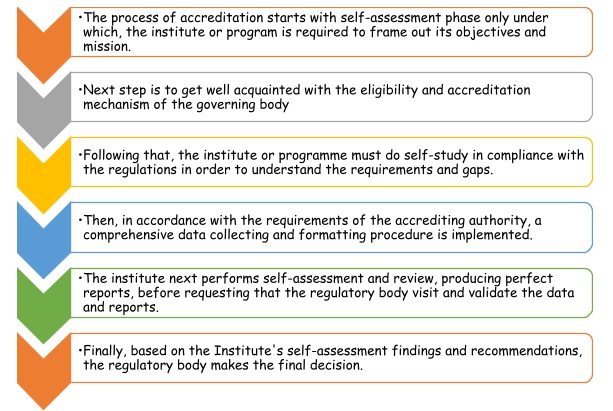
Importance of Accreditation: Accreditation plays a significant role due to following reasons: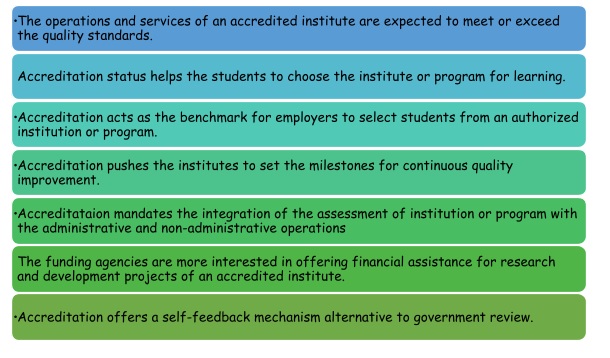
With reference to the above context, one can easily observe the potential of accredited institutes to ensure accountability in the institutes among students and families for their upskilling and advance learning. To achieve the best place in accreditation, institutes are required to undergo rigorous processes for data and reports compilation. We at iCloudEMS are always assisting Higher Education Institutes in upgrading their quality standards with our ingenious products and services. Our accreditation management system is a cloud-based software
which includes SIS and other modules, and is designed for all types of technical and nontechnical Higher Education Institutes, delivering results in accordance with the Washington Accord, LIMA Accord, and Bologna Process.
- Accreditation bodies typically require an analyse data span of several years, but manually organising and formatting such a large amount of data is a laborious process that is prone to redundancy and missing data. Our cloud-based system makes data administration and formatting compliant with rules much easier.
- With only a few clicks, our system can generate a variety of self-assessment and analysis reports, such as SER/SAR/AQAR/IQAC/AACSB, that are necessary for your institution.
- Today, it is essential to upload data to accreditation portals prior to the visit of a peer team; our unique functions make this process easier, including the ability to use prefilled data on the portal during the multiple-year data collection process.
- The information is primarily requested to be entered via responses to a few predetermined questions with respect to different criteria. Our system facilitates the data and results uploading in the same approach.
- Examining one’s own abilities is an important step in the accreditation process, and reports communicate results more effectively than words. We help faculty members by automating the generation of the main self-assessment report, as well as various supporting reports, during accreditation assessments and qualification analysis.
- Through the compilation and management of data in chronological order, our skilled database verification team examines the standards and criteria to be confirmed.
- Institutes can quickly examine the benchmarking standards and acquire a ready reckoner on the present state using our tiered evaluation procedure.
- Our user-friendly system helps the governing bodies in fair and thorough audit of well-organized data and reports with a couple of clicks only.
It can be concluded that iCloudEMS offers well governed digital space to automate and simplify the tedious and repetitive activities of accreditation. Our comprehensive Accreditation management system enables an error-free mapping of learning outcomes with the institute’s mission and vision, for quality monitoring and improvement. Today in the competitive era, it is the best time for Higher Education Institutes to invest in a digital partner like iCloudEMS that can align the workflow with the visionary strategies of the institute to ensure quality assurance and improvement on a regular basis.
How digitization empowers the growth of Higher Education Institutes and the role of iCloudEMS in bringing this digital transformation
In today’s era of computerization, the technology is stretching its wings day by day to improve the digital capabilities of organizations and individuals. Automation and storage are two important horizons of technology that aid the progress of organizations transforming their workflow in quick and inexpensive form. Many developing technologies such as cloud-computing, internet of things, machine learning etc. are contributing to the enhancement of learning, collaborating, and decision making of organizations.
NEP 2020 has advocated the integral use of technology in Higher Education to transform traditional education systems to digitally empowered education systems. NEP has recommended the use of advanced technologies including Artificial Intelligence, Machine learning, Smart classrooms etc. to foster flexible and student-centric learning where focus is on the learning accomplishments rather than the content of learning. Technology catalyses the fulfilment of highest priorities and overcomes various challenges in education sector that include:
- Web-enabled functionalities for the alignment of administration with visionary strategies.
- Smart analytics utilities to gauge students’ learning and program efficiency.
- Technology enabled services for the faculty to enrich the course curriculum and develop e-learning resources.
- Digital environment to help faculty and students to be part of advanced learning and research across borders.
- Technology adaptive pedagogy and research practices to achieve a competitive edge in knowledge and learning.
- Optimum utilization of institutional resources.
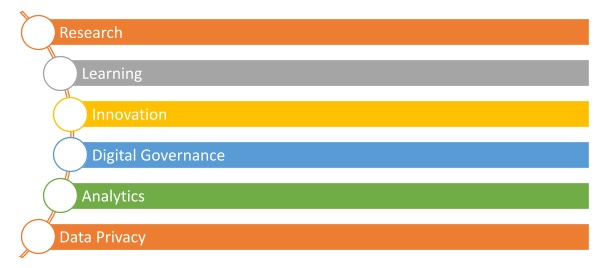
All these digital capabilities focus on the multiple dimension growth of core functions of the Higher Education Institutes to encourage sustainable functioning models of tech-savvy campuses.
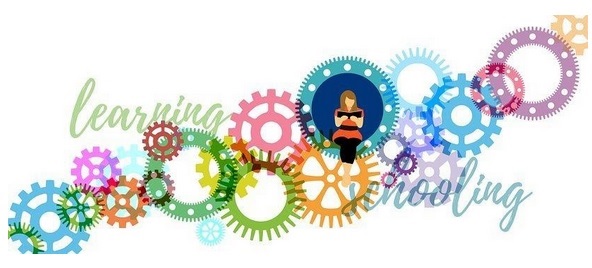
NEP 2020 has taken following major initiatives regarding leveraging technology in teaching-learning measures of Higher Education Institutes to ensure holistic development of students:
- Agencies, such as the NETF, CIET, NIOS, IGNOU, IITs, NITs, etc. will be identified to integrate online education for continuous improvement alongside considering its downside effects on students’ activities.
- The establishment of open, interoperable technology-based infrastructure in the education sector that can give solutions to solve major challenges of the nation related to India’s scale, diversity, complexity and device penetration.
- Online teaching platforms such as SWAYAM, DIKSHA, will be included to provide teachers with a structured, user-friendly, rich set of e-learning tools for monitoring progress of learners.
- An online repository for content creation and dissemination will be established for the creation of coursework, Learning Games & Simulations, augmented reality and virtual reality along with a transparent system for ratings by users on effectiveness and quality.
- Innovative solutions will be framed to address the digital divide for which existing mass media, such as television, radio, and community radio will be extensively used for 24/7 telecast and broadcasts of educational programmes in all Indian languages.
- Virtual labs will be created leveraging online platforms such as DIKSHA, SWAYAM and SWAYAMPRABHA to encourage equal access to quality practical and hands-on experiment-based learning experiences.
- Special training and incentives for teachers will be encouraged to facilitate learner-centric education and creation of high-quality online content.
- Appropriate bodies will be designed and implemented for developing assessment frameworks and analytics using modern education technologies.
- The deployment of blended models of learning will be fostered to maintain hybrid learning approach while promoting digital learning and education, the importance of face-to-face in-person learning is fully recognized. Accordingly, different effective models of blended learning will be identified for appropriate replication for different subjects.
It is well mentioned in NEP 2020 that technology in education is a journey and not a destination and capacity will be needed to orchestrate the various ecosystem players to implement policy objectives. In the light of pandemic digitization has been proved the life-saviour for organizations. The education paradigm shifted to remote learning overnight. In such time of crisis, thankfully some Education management systems such as iCloudEMS paved the way to uninterrupted learning & administration and replaced the chalk and board model with the digital learning in a blink of eye iCloudEMS is a market-leader that offers cloud-based Education Management to bring digital transformation in Higher Education Universities to handle every vital operation and cater the needs of all stakeholders for accomplishment of more creative and productive goals. Our ingenious services and products bridge the gap between teaching and effective learning and also extends the digital capabilities of institutes in terms of infrastructure, ecosystem development, assessment, learning, and teaching. Our major key areas include:
- Cloud-based platform to store massive amounts of data and records that can be accessed without any time or place constraints, such technology eliminates the manual storage and retrieval of information, and along with its limitations.
- Digital medium to choose and allot the courses of students in line with CBCS guidelines, the credits and other attributes of courses are also saved digitally.
- Personal Learning Management System that aids the creativity in course creation and delivery under OBE framework and makes the learning flexible and student-centric for upskilling the students.
- Student lifecycle management system for the digital organization of the integrated academic journey of students from being prospective to alumni.
- Accreditation management system that automates the groundwork of accreditation and simplifies the compilation of bulk data and reports for the associated staff members.
- Online Classes and Exam management system for the quality learning and assessment with clearly mapping of results to measure the accomplishment of learning goals.
- Managed services for ERP of Higher Education Institutes that offer a paper-free approach for important academic and non-academic tasks of Colleges and Universities and assist in channelizing the efforts of faculty in upgrading the standards of research & innovation.
Information technology has brought agility into the educational sector by restructuring the work situations, abridging thoughts from actions and redefining the approaches to mitigate the ongoing complexities of various activities in institutes. In this technofix age, iCloudEMS always comes forward in upgrading Higher Education Institutes with its web-based products and services as we believe that the success of any educational institution is directly proportional to the ability to comprehend, accept and integrate new and effective result-oriented technology into its work.
How to design the course file and how iCloudEMS simplifies its generation
Outcome-based Education(OBE) has become the buzzword in context with delivering quality education in Higher Education Institutes.The effective execution of OBE model demands the relevant curriculum design and effective teaching-learning processes that can demonstrate the acquired skills in students at the end of the program.
What is OBE and what is its need
William Spady is considered as the father of Outcome-Based Learning(OBE)and he might not have thought that his brain child would bringt ransb formation in Education sector. The basic principles of Outcome Based Education implementation include:
- Learner-centric – Learner governs his own learning and can measure his proficiency in his desired skill-set over time.
- Clear Expectations-The predefined specific outcomes clear the expectations of learning and foster the focus of learning.
- Scientifically design and delivery – OBE approach necessitates the curriculum design and delivery with a clear definition, including the expected outcomes and continuous mapping of the outcomes with the student’sperformance.
- Highexpectations–The ultimate focus of OBEis to enable learners to give the highest level of performance for which teachers should always be available as facilitators to motivate and guide to lead the path of success.
- Diverse opportunities –OBE does not allow to follow ‘One size fit all’ approach, thus make the students learn at their own pace. Such flexible learning expands the range of diverse learning opportunities according to their interests and needs of students.
Thus, Outcome based education (OBE) is learner-centered education framework that tracks the learning trajectory of students by measuring knowledge, skills and attitudes of students through learning outcomes during the course of the program. The accreditation bodies such as NAAC, NBA etc. have mandated the OBE implementation in Higher Education to empower the practical and flexible learning than memorize and reproduce the content.
Various features of OBE include:
- OBE framework focuses on the right teaching-learning of students in line with the skills they should develop after they are taught.
- OBE encompasses the framing of curriculum, teaching practices, assessment and results that can clearly reflect the capabilities or qualitiesof students rather than mere a credit count.
- Discourages traditional education approaches based on direct instruction of facts and standard methods.
- It encourages the demonstration of acquired knowledge and skills of students that they have learnt during the program.
Limitations of our traditional Education System are:
- The instruction content and delivery are more schedule and time based rather than results based.
- More focus is on rote learning than the achievement of 21st century competencies.
- The graduates do not get the sufficient exposure to soft skills, interpersonal skills, analytical skills and working attitude.
Measures to implement OBE in Higher Education Institutes are as follows:
- Define Vision and Mission statement of the department taking the reference of Vision/Mission statement of the Institute.
- Next Program Educational Objectives(PEOs) and Program Specific Objectives (PSOs) are designed considering the defined Vision and Mission statements.
- Map Mission Statements with Program Educational Objectives(PEOs)
- Design program outcomes considering the expected analytical abilities of students.
- Map Program Educational Objectives with Program outcomes
- Define course outcomes in compliance with Bloom’s Taxonomy for each Course
- Map COs with POs appropriate to the levels of Bloom’s Taxonomy
- Design instructional strategies for each topic
- Map topics of a course with its Cos.
- Derive test items or rubrics for each CO of each course
- Define delivery methods for each topic/COs
- Prepare session-wise plan for the courses
- Design questions in the framework of Bloom’s Taxonomy levels & other guidelines outcomes related guidelines.
- Track students’ performance by proposing proper remedial measures to redesign teaching strategies.
- Map and evaluate students’ performance against CO threshold,course-wise
- Semester-wise mapping and evaluation of students’ performance against PO parameters.
- Incorporate direct/indirect assessment tools to measure the attainment of each PO.
- Compare PO attainment for the previous three academic years and take remedial actions for continuous quality improvement
- Finally assess the attainment of Program outcomes and Learning objectives.
The approach to implement Outcome based learning can be summarized as:
- Systematically design and develop Outcome Based Curriculum.
- Develop appropriate ICT based Pedagogy Framework Tools to train faculty members to design, develop, monitor and review curricula based on the Industry / Expert feedback.
- Include references to appropriate learning material for all define outcomes, include case study, unsolved problem and resources in the respective outcome.
- Include adequate number of nontrivial practice problems, assignments etc. matching every course outcome to allow students to test their learning success.
Many accreditation bodies such as NBA in its criteria 2 has asked the details of program curriculum teaching-learning processes undertaken throughout the semester and such data is to be maintained for several years that mandates the faculty of Higher Education Institutes to design a compiled documentation that comprises all the details of batch and its various attributes like curriculum design, delivery, assessment, evaluation, reinforcement of Teaching/Learning Processes, and continuous improvement records to reflect the level of attainment of course outcomes. For the actualization of OBE model in Higher Education Institutes, it is necessary to have all the data and reports of students and courses, so that the learning trajectory can be tracked and effectiveness of program can be gauged according to the results of outcomes’ accomplishment.
The course file is enriched on three dimensional scales of all the academic and details of the course taught in a semester. But creating and maintaining course file is challenging and a time-consuming effort of the instructors. iCloudEMS is a digital assistant of the instructors in simplifying the rigorous procedures in the present technofix era. We offer leading-edge products to automate all the imperative academic functions including course file generation. Our cloud-based platform provides unified solutions to store, access and process huge amount of generated data and records of courses, faculty and students. Faculty can retrieve all the necessary details with a couple of clicks only and can tailor their course file under the framework of OBE and Bloom’s taxonomy.
Checklist of the necessary details and statistics that are required to be hold in a course file
- Vision and Mission of University
- Vision and Mission of Department
- Academic calendar of University and School
- Time table faculty & Class
- Course syllabus
- POs, PSOs, PEOs & COs
- CO-PO-PSO Mapping
- Lecture plan
- List of students
- Tutorial Sheets & Assignments with sample solutions
- Question Paper for Quizzes, Sessional and End term Examination
- Evaluated Answer Scripts with award sheets to reflect attainment level of outcomes.
- Award sheet of assignments and End-semester examination with attainment.
- Study material for content beyond syllabus
- Innovative Teaching/Learning techniques used
- Attendance Report of the desired period
- Exhaustive Question Bank
- Sample Lecture Notes
- Course Exit Survey
- Various reports including Final Attainments, Result Analysis, and Feedbacks.
Role of iCloudEMS in generation of course file:
iCloudEMS allows to have an eagle view to all the latest and previous records on the dashboard of a faculty member that can be accessed with their specific credentials. Faculty can select and customize the data in accordance with the subject and batch of the required course file. With the help of iCloudEMS, it is no longer necessary to spend your important hours on this laborious task that can be easily completed in seconds only.
- We offer dashboard entry of students’ database with all their necessary personal and academic details at the admission stage that can be easily fetched any time for maintaining and updating records.
- We have automatic time table generation system to prepare multiple type of timetables i.e., class wise, room wise, faculty wise without any clashes and redundancy.
- We provide computerized course allotment utilities that assist to choose the desired courses with its associated credits scheme that can be retrieved and utilized for the required reports.
- Our OBE supported functionalities help the faculty members to design and map the assignments, question bank and end term examination in the framework of OBE and Bloom’s taxonomy that aligns the workflow in line with OBE guidelines.
- We deliver personalized learning management system to create online repository of lecture notes and other study material that can be easily downloaded for documentation of course file.
- We restrict the attendance marking on portal unless uploading of the digitized copy of lesson plan of with all the necessary details of the courses, that enables the instructors to easily create and access this important file.
- Our cybernated attendance marking system provides the statistical attendance reports at any time during the program.
- We provide managed services to the ERP of Higher Education System to automate and simplify the administrative and non-administrative tasks of Colleges and Universities.
- The Online Examination system of iCloudEMS fosters all examination and evaluation related data and reports in the OBE paradigm including all imperative COs-POs mapping analytical reports to gauge the abilities of students and empower continuous quality improvement.
- We deliver multiple survey and feedback features with powerful reporting tools to maintain and fetch as a course file component and enrichment of academic standards.
In a nutshell, it can be mentioned that iCloudEMS is built to offer hassle-free management of all the important activities in the Higher Education Institutes. It enables faculty members to be more creative and channelize their efforts in more productive way as we are here to take care in aligning their workflow in compliance with the visionary requisites and guidelines.
How iCloudEMS is beneficial to Higher Education Institutes
The ultimate objective of all educational institutes is the accomplishment of learning goals in the best possible manner. In today’s dynamic world of Education, it is getting difficult for the institutions to maintain the quality standards along with the plethora of daily activities. Manual intervention in such a large number of activities can lead to redundancy of information, missed information or wrong information that can sometimes produce irreversible consequences. The advancement in Information and Technology has brought solutions and alternatives to such workflow issues with the Education Management Software (EMS). EMS is a set of software modules that automates the imperative daily administrative and non-administrative activities and assists the institutions to streamline the workflow in line with regulatory guidelines. The major benefits of an efficient EMS include:
Huge data storage
The massive amount of important data and reports are generated at each and every level of process in the campus. The web-based Education Management System makes the herculean task of data storage and retrieval easy for all stakeholders.
Cost-effective
The cloud-based services of an efficient EMS avoid the hardware requirement and its maintenance that makes it a cost-effective utility to solve campus tasks.
Creative teaching-learning
The smart features of an effective Education Management Solution make the teaching-learning practices creative and engaging that helps to bridge the learning gap.
Paper-free approach
A large number of non-academic tasks such as admission, fee collection, result generation etc. are paper-based and require much time and efforts of associated staff. A flawless EMS saves the valuable energy of the staff members and supports all the activities with a couple of clicks only.
Data Privacy
The access of data with individual login credentials ensures the right access of data to right users that enhances the data safety and privacy.
Mobile-supported
Today smartphones have become an indispensable part of life. So it has become inevitable to design mobile technology supported EMS that can make the information at the fingertips of the stakeholders.

iCloudEMS promises to offer prime cloud-based Education Management in Higher Education Institutes that bring digital transformation in handling the important academic and non-academic operations of the institute for efficient utilization of available resources for accomplishment of more productive goals.
Our following breakthrough products and managed services foster student-centric learning and cater to the needs of all stakeholders.
- Accreditation Management System:
iCloudEMS offers a cloud-based Accreditation Management System, an integrable solution to generate, collect, organize and administer all required data and reports in the predefined formats given by regulatory bodies such as NAAC, NBA etc. and helps Institutes throughout the preparation and submission of quick and accurate information for evaluation. It also includes many graphical and analytic tools with collaborative dashboards to easily track the progress of data submission. Its main features and benefits include:
- Predefined Question Set in line with different criteria of governing bodies that eases to enter and govern data for faculty on a centralized platform.
- Standard utilities and formula set that help them to generate main reports and supporting reports for assessments and qualification analysis.
- Powerful reporting tools with a standard formula set to generate analysis reports such as SER/SAR/AQAR/IQAC/ AACSB.
- We also offer provision for kind perusal of data by concerned authorities.
- Innovative templates to streamline the administration of bulk data uploading for several years.
- Swift multilevel evaluation process for management to benchmark standards and get a ready reckoner on the current status.
- Automatic and precise results with a couple of clicks to ease the DVV clarification by governing bodies.
2. OBE supported Learning Management System
Our personalized interactive Outcome Based LMS brings the right fusion of technology in the traditional chalk-and-board model to strengthen the deployment of prime technology in upgrading the academic standards at par with global level. It provides a common digital platform for students and teachers for knowledge sharing and tracking the learning trajectory via user-friendly gateway. Its innovative functionalities help the instructors to create and deliver the content under the OBE framework. Have a look at the major benefits of our OBE-LMS product.
- Faculty can easily plan and design the curriculum, course content, assignments in the framework of OBE and Bloom’s taxonomy model.
- They can create online repository of e-content and deliver
- Can create online storehouse for e-content such that students can find the content available prior to session for quality learning
- Students can set milestones and govern their learning with the help of easy access to study content and performance records.
- Our system fosters the teacher-pupil interaction and increases the students’ engagement in learning sessions.
- Parents can actively participate in learning of their children and Can get complete insights of their wards’ attendance and performance grades anytime.
- They are able to judge their children’s all-round progress with OBE and Bloom’s levels mapping records. and can have effective communication with teachers and management.
- Management can get the overhead view of course planning and coverage progress to find any gap and take well-informed decisions at all levels.
3. Online Classes and Exam management system
iCloudEMS utilizes a 360-degree platform that presents unified solutions to Online Exam Management System and LIVE Classes services that work on all the intricacies of classes and examination that replaces the cumbersome manual operations with a disciplined digital governance for effective planning and execution of time and resources. It offers following benefits to cater the assorted needs of all stakeholders:
- Faculty can organize the interactive LIVE classes supporting multimedia to boost students’ engagement
- They can easily generate Question papers using extensive question banks and innovative template papers in line with OBE and Bloom’s taxonomy norms.
- Virtual examination space with LIVE proctoring maintains the integrity of examination space and can promote smooth planning and conduction of exams.
- On-screen evaluation and grading save the time of faculty members and support quick and flawless evaluation and results.
- Students can reap the benefits of Online Classes and Examination sessions to accomplish their learning goals at their own pace and at their own space.
- Administration can seamlessly plan and manage material and human resources to conduct classes and examinations.
- Management can get the eagle’s view of the cyberspace of LIVE classes and Examination at a single click and can continuously put their efforts towards raising the academic standards for continuous quality improvement.
4. Student Lifecycle Management System
iCloudEMS assists the Colleges and Universities with its versatile Student lifecycle management system to access and process a plethora of information with a couple of clicks, anytime and anywhere throughout the academic journey of all students. It gives integrated solutions to smoothen student recruitment and management for both administration and students to save their valuable time and energy for achievement of more creative goals. The major benefits of our innovative product comprise of:
- Faculty can save their time and efforts to access and process integrated databases of students from being prospective to alumni.
- They can easily track and analyse the cognitive abilities of students with OBE and Bloom’s taxonomy levels mapping.
- Students can retrieve and update their required information on a central platform only for different uses and can easily perform tasks such as fee payment, hall ticket, timetable etc.
- Parents can be more relaxed with online admission and fee payment tasks can involve in the learning and other activities of their children.
- Management can experience a technology-oriented transparent ecosystem for the quick analysis of accomplishments.
5. Managed Services for ERP
iCloudEMS offers Managed Services comprise to ERP of various Higher Educational Institutes different that digitize various academic and non-academic operations like pre-admission, admission, fee payment, attendance, assignment, examination, library management, accreditation management, etc. and channelizes the efforts of all stakeholder for quality improvement. The significant benefits our managed services include:
- Hassle-free admission process from pre-admission to post-admission activities.
- User-friendly fee payment and record maintenance that adds convenience for both students and administration.
- Computerized time-table preparation and management to overcome the challenges in multiple time table generation.
- Centralized digital training & placement avenue to facilitate recruitment activities.
In a nutshell, it can be mentioned that in the era of innovation & technology NEP has recommended Higher Education Institutes investment should invest in the generation of tech-savvy infrastructure and services to bring the best of time and energy of the staff members and iCloudEMS is a reliable partner to bring the digital revolution in Higher Education Institutes.






